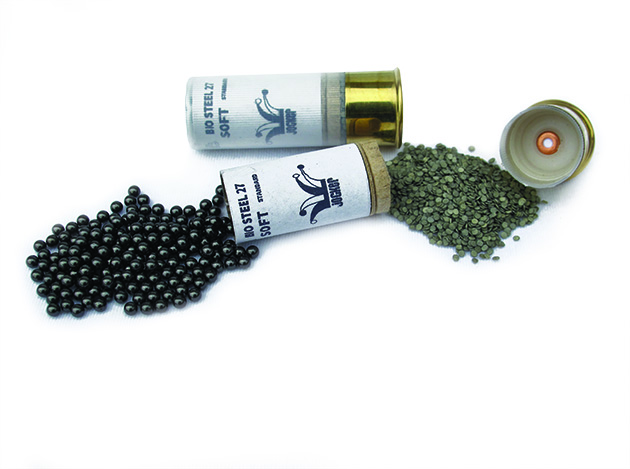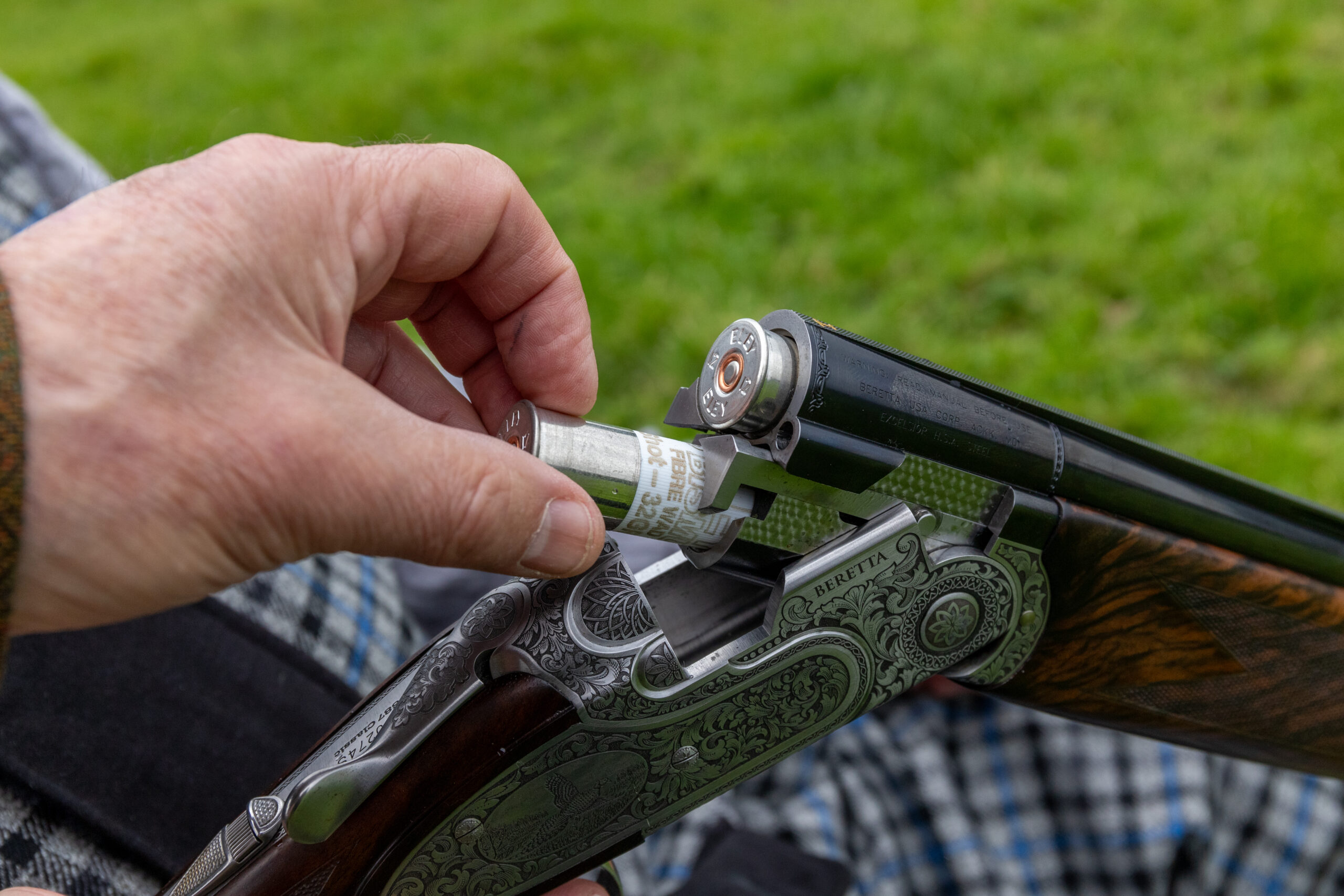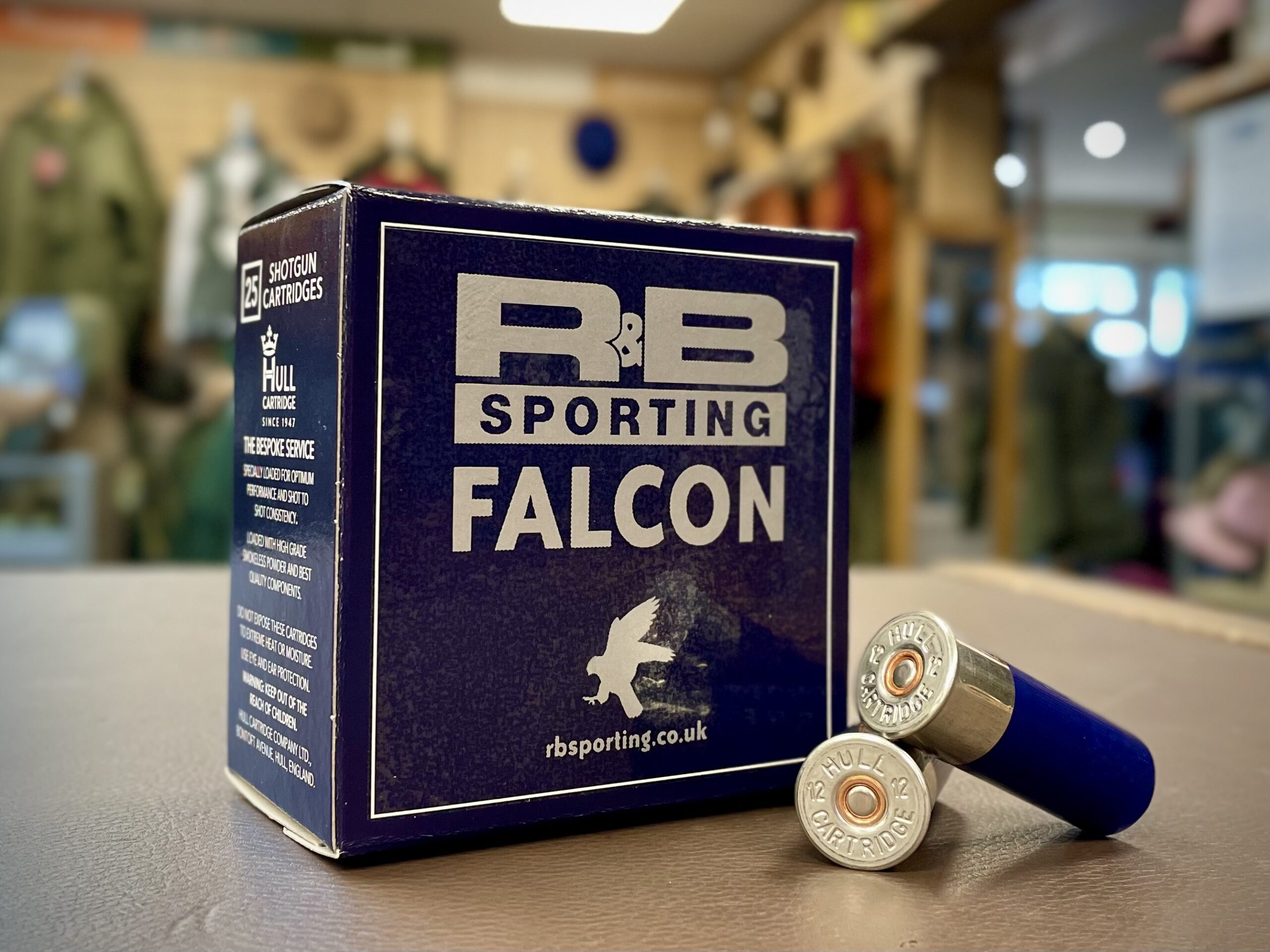The Bio ISO Steel 27 cartridge from Jocker – it’s impressive
Richard Atkins takes a look

The components of the Jocker Bio ISO Steel 27 cartridge
French company Jocker has become much better known in the UK in recent years and particularly so since its products have been distributed here by Shooting Star of Suffolk. Having gained a rising profile with its budget clay pigeon cartridges, which came at a very good price at a time when cartridge costs were rising, Jocker has now become a fast-growing name in the development of eco-friendly and non-toxic cartridges.

The carton makes it clear that these are standard steel loads
The timely Jocker Bio ISO Steel 27 cartridge
The big demand at this time is for the game season, and so the Jocker Bio ISO Steel 27 cartridge is timely. These come smartly packaged in cartons of 25 that carry a duck-flighting scene on the front. Some pheasant shoots include a pond or two and so there should be no need to swap from lead to steel if these cartridges suit your needs.
The Jocker Bio ISO Steel 27 cartridge cartons make it very clear that these are steel shot loads. Sensibly they also have ‘standard velocity’ clearly printed on the top flap, thereby avoiding any confusion with high-performance steel loads. These cartridges are intended for use in sound, nitro proofed guns that may not have been steel shot proof tested and marked with the fleur-de-lys symbol. They are not recommended for guns with damascus or twist steel barrels, as printed on the carton side.
An image of the 100% biodegradable, patented Jocker paper wad is included on the carton front and rear, and the bore, case length, shot load weight and size, and height of metal case head are all clearly printed on the top flap for easy reference.

The main tube has the cork or fibre wad glued inside its base
The cartridge
The cartridge case is a clear and lightly ribbed, 67mm-long parallel plastic tube with 16mm-high brass-plated steel head using Maxam primers with paper-sealed flash holes. A novelty of the Jocker wad is that the cartridge details are printed on the wad rather than the case, hence the clear plastic tube so that the details are visible through it.
The special-blend propellant is light greenish/grey, of small-disc form and appears also to be a Maxam product. At 27.6 grains the powder load is quite high for the shot load, this being around 12% more powder than in the Bio 28g lead shot cartridges tested previously. This powder burns cleanly, consistently and provides the velocity required well within the CIP limit for 67mm cartridges.
Steel shot loads with their differing volume required to accommodate them and taller shot columns which increase sectional density – plus special wads – all conspire to make life difficult for cartridge makers in producing optimal loads within the current limitations of CIP rules. As we shall see, Jocker has achieved a commendable balance here.
The wad
The Jocker bio wad is, of course, at the heart of the Jocker Bio ISO Steel 27 cartridges, making them both possible and special. Shooting Star worked closely with Jocker in developing the new, all-paper/fibre, full-cup wad in response to the increasing desire to use fewer plastic cup wads in game and clay cartridges. Aware of my background in cartridges and shotguns, to my delight, Shooting Star contacted me at an early stage in the wad’s development.
I now admit to some personal satisfaction to see that one design suggestion I had proffered, after examining an early prototype, appears in the production wad. This involves the fibre card gas seal skirt, which was initially a plain pressed item. I suggested this might prove better able to expand to form an effective gas seal if the cup itself were formed with ‘pleats’. From experience many years ago, with Winchester skeet cartridges that used fibre wads with a similar gas seal skirt, I recalled the fibre gas seals in these cartridges had used this method to good effect. It means there is a little more material available to increase in diameter under gas pressure when emerging into the forcing cone and barrel, where it must expand to form the seal. The pleats help prevent the relatively weak (compared with HDPE plastic) skirt from tearing upon expansion.
The Jocker bio wad achieves its eco-friendly status from being of paper, fibre and cork construction. The wad comprises the following components:
• A sturdy paper/cardboard tube
• A cupped cardboard gas seal
• A fibre or cork base wad
• A plain card disc between the gas seal and fibre wad
The main tube has the cork or fibre wad glued inside its base.
Different length cork or fibre wads are used to adjust the internal capacity for the different shot load weights. This can allow the same tube to be used for different shot types and weights.
The novel Jocker paper wad may have seemed a fascinating gamble at the outset but seems to be paying off.
The shot
The steel shot used in Bio Steel cartridges is of excellent quality, being round and consistent in diameter within just a few thousands of an inch. The pellets have also been well polished and coated with a black, possibly graphite coating, which gives them an attractive finish that helps resist corrosion. A polished surface finish also assists in pellets running smoothly through loading machines for more consistent charge weights.
The pellets, at 3.25mm diameter, are at the maximum allowed for standard steel cartridges under CIP rules. This is slightly larger than UK No 4 lead shot (3.1mm diameter) but less than No 3 (3.3mm diameter).
These Bio Steel cartridges are, presumably, nominally a 27g shot load, hence their name. Weighing out several shot charges showed that they are, in fact, fairly generous and closer to 28g in weight on average with 428 grains of shot (27g is 416.6 grains). It being steel, I obviously cannot test shot hardness, but CIP also sets down maximum surface and core hardness values for steel shot used in shotgun cartridges.
These cartridges were sent for testing at the Birmingham Proof Laboratory with results as recorded here. The patterns in the chart were recorded using a modified (half) Mobil choke in a standard-bore gun with short forcing cones. Further patterns, with modified and improved cylinder chokes, at 30 and 40 yards are also listed.
 The proof report confirms these cartridges are about as fast as is practicable to achieve and remain within the CIP velocity limit for standard steel cartridges. This velocity combined with CIP maximum pellet size ensures these cartridges produce the maximum striking energy you can get in a Standard Steel specification cartridge.
The proof report confirms these cartridges are about as fast as is practicable to achieve and remain within the CIP velocity limit for standard steel cartridges. This velocity combined with CIP maximum pellet size ensures these cartridges produce the maximum striking energy you can get in a Standard Steel specification cartridge.
If either velocity or shot load weight were any higher, then the momentum figure would most likely fall outside the permitted CIP maximum. When you consider these limitations, it is clear just how difficult this is for manufacturers – they are now battling not only with the CIP specifications but doing so while developing new, biodegradable wads as the move to ditch HDPE plastics gathers pace.
Jocker has undoubtedly done very well to produce these Bio ISO Steel 27 cartridges and trusting its wad development and cartridge loading expertise to bring it so close to the permitted optimum performance.
I have heard reports suggesting that some overseas manufacturers deliberately aim for a slightly lower velocity/momentum level to avoid the risk of batches being rejected.
Observations
This is, of course, a time when we are all facing a learning curve as we are faced with using totally new products to tackle the areas of shooting sport affected by proposed change. Steel shot behaves differently in our guns to lead (and other) shot and creates its own ballistic limitations. Patterns will be different, as will retained pellet energy.
We often read that steel shot patterns more densely than lead shot. From some of the limited testing with steel shot I have conducted so far, it is clear that some steel shot cartridges pattern more tightly than others (just as premium lead shot cartridges pattern more closely than most budget lead cartridges).
As the pattern results clearly reveal, these Jocker cartridges are indeed capable of producing patterns more tightly concentrated than the choke boring used. For these tests, the cartridges were fired through extended Mobil chokes through a gun with standard bore size and short forcing cones. Your gun and chokes may, of course, perform differently, and that is why I recommend that, whenever possible, shooters do what they can to find out for themselves how their gun and chokes perform with the cartridges they choose to use.
This is an important transition in our shooting lives and, as with the cartridges we have been using until now, it behoves us to be the best we can and discover the limitations of our equipment as this will influence how well we perform in the field.
The Jocker Bio ISO Steel 27 cartridges are loaded into a 67mm case, which makes them suitable for a great many guns still in regular use today but built long before steel shot proof was ever thought of. This makes these standard steel cartridges an interesting and potentially very useful option for those with older, predominantly side-by-side shotguns, many of which will have 2½in chambers. Providing your gun is nitro proofed and still in sound condition, then these cartridges are designed to offer a suitable steel shot option.
In the field
How far they will work in the field will depend on many factors, including how well you place the pattern on the quarry. As is clear from the ballistic details, they will provide the maximum pellet energy that can be readily obtained from any standard steel cartridge.
The pattern results also clearly show that these cartridges are capable of producing high percentage patterns. As the figures indicate and pattern images show, even the improved cylinder choke performs very well at 30 yards. At 40 yards, the modified (half) choke is still looking effective, depending upon the quarry.
We should all be well aware that all patterns are a balance between sufficient pellet energy and adequately dense patterns to ensure, so far as is possible, clean kills.
Remember that it is pellet strikes that kill game, not percentages. This helps when considering what will work for you, through your gun. Large pellets retain energy longer, but there are fewer of them in a shot load.
You can see this effect when checking the pattern result images against the average pellet density percentage recorded for them at the two distances. These results indicate that around 40 yards would seem a sensible maximum sporting range, where pellet energy should remain sufficiently high while the pattern density is reducing.
Note that the improved cylinder pattern at 30 yards is almost as dense as the modified choke; the central density (CD) figure, though, shows a much more even spread at that range at 66% to 81%. This means a more even distribution of pellets for a very effective pattern (and less likelihood of a heavily smashed bird). It also provides a greater margin for error in shot placement.
No one can consistently judge the precise distance to a moving target in the heat of the moment and that is where taking all the factors mentioned here into account will help in becoming a better all-round Shot as well as giving the dogs less long-distance work to do.
Test standards

‘Confetti’
You may well notice some ‘confetti’ when shooting with Jocker Bio ISO Steel 27 cartridges. This is the paper and cork wad breaking up on hitting the air as it emerges from the muzzle at high velocity, as it is intended to do. These steel shot wads are a little thicker than the first Jocker lead shot paper cup wad and the shot cups are also more efficiently scored internally to ensure they open up rapidly upon exit. This works well and wad fragments will be found considerably closer to the firing point than any other wad type I have encountered.
Note that this breaking up is intentional and occurs after the wad has left the bore; it does not indicate wads breaking up inside the bore. I prefer standard bore size and short forcing cones for my guns, as I use a lot of fibre wad cartridges for clay shooting. This Jocker wad performs well in this bore type. It may be prudent to seek advice from the makers/importers of guns with over-bored bore sizes and especially those with extended forcing cones, as this asks more of any wad in that much enlarged section of barrel immediately ahead of the chambers. The typical English game gun will have standard bore size and short cones and, from my experience thus far, these cartridges should perform well in them.
You may notice that felt recoil is a little more than with a similar weight lead shot game load, especially if using a lightweight English or English-style game gun. That is to be expected when velocity is at the maximum and may be 30m/sec higher than a 28g lead load. That is an inevitable drawback of the need to impart sufficient energy into the steel shot pellets. These cartridges should prove perfectly acceptable in a well-fitted gun in good condition, as they were when testing in a moderate weight over-and-under.
Feedback
Feedback on the Jocker Bio ISO Steel 27 from field trials has been positive with experienced game shooters achieving good results on pheasant and duck. Picking your birds and knowing your limitations should produce good results. From some comments thus far, a number of shooters have been very pleasantly surprised how well they have shot with these cartridges, despite initial reservations. Pigeon and corvid shooters should find them effective too.
These cartridges retail for around £369 per 1,000, which is competitive in this non-toxic and biodegradable market. The only thing to do now, of course, is to buy some, test them in your gun and then see how they perform for you in the field. From my findings reported here and the reaction from in the field, I would anticipate that there will be some more positive feedback to come.
Tech specs
- Configuration Jocker 27g No 4A steel shot bio fibre cup wad
- Shot load 428 grains
- Pellet (count per oz) 189
- UK shot (size/CV) 4A / N/A
- Pellets in 30in dia (Av) 82
- Pellets in 20in to 30in 52
- Pattern 73%
- CD 61%
- Velocity 419m/sec (1,377fps) SD 7.5
- Recoil (M) 11.3Ns
- Pressure (bar) 670 bar








